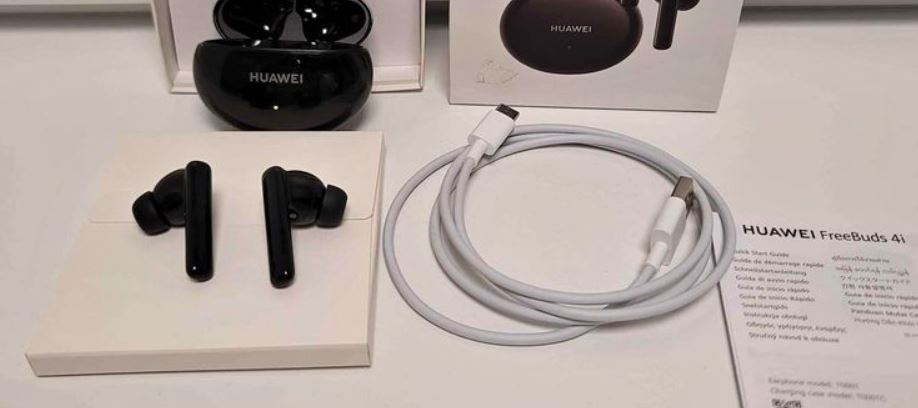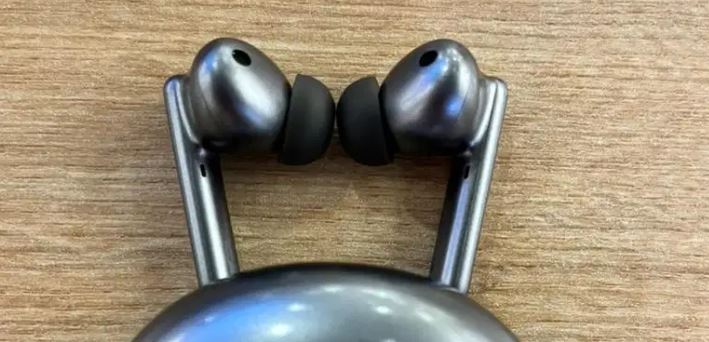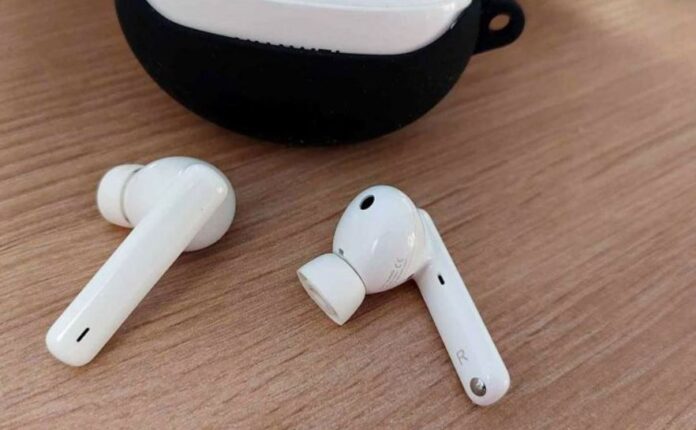Less than a year after the already very convincing FreeBuds 3i, Huawei was back with a new pair of noise reduction true wireless in-ear headphones Huawei FreeBuds 4i at an aggressive price. A speed which does not deprive the FreeBuds 4i of very tangible improvements.
Current Best Price on Amazon: $59.99
Table of Contents
Pros and Cons
Pros
- Clear, detailed and dynamic sound.
- Very responsive, flattering bass without ever becoming boomy.
- Outstanding comfort and fit.
- Excellent battery life.
- Extremely compact storage case.
Cons
- Lack of neutrality, slightly aggressive mediums.
- Disappointing noise canceling.
- Poor voice capture in hands-free kit mode.
- Very few controls available on the earbuds, control customization impossible on iOS.
Design
The 4i join Huawei’s FreeBuds range in the in-ear or semi-in-ear wireless headphone segment — as indicated by the “i” suffix in their name. They succeed the FreeBuds 3i released in May 2020, and replace them as the most affordable true wireless earphone model in the manufacturer’s catalog.
Gone is the slender design of the FreeBuds 3i and the earphones that can be stored “lying” in their case: the 4i return to a more classic concept, where the stems of the earphones are “planted” in the storage case. This classicism suits them very well, since this new case is much more pleasant to use.
Without sacrificing any of the extremely reduced size of its predecessor, it simply makes it much easier to grab the headphones, without fear of dropping them.

All is not perfect, however: the fairly strong friction between the headphones and the inside of the case can give a somewhat cheap impression, and makes handling the headphones not always as smooth and reassuring as one would like.
The rest of the manufacturing quality is to match: suitable, without impressing in any way. The shiny plastic of the headphones and the case is certainly not the dirtiest, but it still catches fingerprints a lot – especially on the black version that we are testing here. The earphones do not benefit from any IP certification, so care must be taken not to wear them in the rain.

The headphones are supplied with a USB-A to USB-C charging cable whose length reaches 1.20 m – instead of a few centimeters with many competitors; we appreciate the effort! The case is however not compatible with wireless charging, this luxury being reserved at Huawei for the FreeBuds Pro.
Controls
The controls available on the earphones are very modest in number: a touch surface on the back of each earpiece, recognizes double pressing or long pressing, and that’s it. By default, the first of these interactions acts as a play/pause/answer button;
the second makes it possible to alternate between the different modes of management of external noise (noise reduction, transparency mode and passive insulation). However, there is no trace of navigation between tracks, and even less of volume adjustment. It’s very cheap.
Comfort
The semi-intra design of the FreeBuds 4i draws heavily from that of Apple’s AirPods Pro. And that’s actually a very good thing: with their head noticeably thinner than the 3i, the 4i is an absolute model of comfort.
They produce no sensation of intrusion into the auditory canal, no marked pressure points on the concha of the ear, which does not prevent them from holding perfectly in place in almost all circumstances. Even light sports practice (cycling, jogging) is possible without running a great risk of loss.
Of course, as always with earphones, these impressions can vary depending on the ear morphology of each individual; but the FreeBuds 4i should fully satisfy the vast majority of their users. As is customary, they are supplied with three pairs of silicone tips of different sizes to provide as universal a fit as possible.
Audio
The quality of audio reproduction is undoubtedly the big surprise reserved by these FreeBuds 4i. Far from the acoustic compromises usually made by true wireless headphones in their price range, Huawei’s headphones provide extremely assured performance, with which there is very little to complain about.
Truth be told, the one and only thing that keeps them from competing with some of the market benchmarks is their slight lack of neutrality.
We are not talking here about the accentuation of the bass: certainly quite marked, it remains however largely acceptable,
especially since the very astonishing discipline of the membranes in the low frequencies avoids any overflow on the higher frequencies and any feeling of “boomy” bass.
On the contrary, we can even find this generosity of the bass beneficial, insofar as it compensates for the absence of physical sensation linked to listening via intra-auricular. The electronic kicks, for example, are particularly well highlighted, without ever becoming overwhelming.
No, it is above all the highlighting of frequencies between 1 and 2 kHz that could tickle the most sensitive eardrums. It clearly accentuates the incisive side of the sound, with, for example, snare drum hits whose intensity may seem excessive.
The feeling of proximity to midrange sounds, especially human voices, is also noticeably amplified, which can give the feeling of a somewhat compact stereo stage. This character is especially evident on acoustic music, with which the FreeBuds 4i are slightly less comfortable than on “amplified” music.
Active noise canceling
When it comes to active noise reduction, on the other hand, the FreeBuds 4i have a little disappointment in store for us – especially since they take an astonishing step backwards in this area compared to the 3i. The attenuation of outside noise is certainly real and perceptible, but far from the 22 dB promised by Huawei.
Battery Life
Autonomy was the great weakness of the FreeBuds 3i, whose very short 3 hours of endurance were really not up to the standards of the moment. A weakness that Huawei assures us has corrected for these FreeBuds 4i – and practice confirms it.
These are 7 hours of continuous operation that the headphones were able to achieve during our measurement, and even a little more than 9 hours 30 minutes by deactivating the noise reduction.
It is certainly, in both cases, about 30 minutes less than what the manufacturer promised us, but no matter, that does not detract from the fact that the FreeBuds 4i are among the most enduring headphones in their category .
The storage case, on the other hand, is less impressive, since it only provides a little more than a full charge to the headphones. However, this is enough to achieve a total autonomy of just over 15 hours, quite honorable.
Connectivity
The broadcast latency of the audio signal in Bluetooth is 249 ms. It’s about average for today’s true wireless headphones, but it’s still a high value in absolute terms. When it translates into sound/image lag when watching a video, this latency is obvious and very uncomfortable. Fortunately, the FreeBuds 4i are able to implement automatic lag compensation with most major video playback apps.
On the other hand, you have to give up on video games, which simply become impractical with such a delay in the audio track.
The voice capture offered by the hands-free kit of the FreeBuds 4i unfortunately does not go beyond the strict minimum acceptable. Its quality is certainly correct during quiet indoor use, but it collapses outdoors.
Even in the absence of nearby noise sources, the headphones struggle to separate the user’s voice from the background noise, and intelligibility becomes extremely poor. In town, near a busy traffic lane, we can even speak of perfectly zero intelligibility. The FreeBuds 4i are therefore clearly not recommended for phone addicts.
Conclusion
The FreeBuds 4i are certainly not without faults – in addition to their disappointing noise reduction, we especially think of their controls which are too scanty. But that does not prevent them from boldly teasing many supposedly more prestigious models, thanks in particular to extremely solid comfort and sound performance. A great success.
Huawei FreeBuds 4i Specs
- Height: 37.5 mm
- Width: 23.9 mm
- Depth: 21 mm
- Weight: About 5.5 g
- Battery capacity Per earbud: 55 mAh (min.)
- Battery capacity Charging case: 215 mAh (min.)
- Music playback duration: 10 hours (with noise cancelling disabled)
- Music playback duration: 7.5 hours (with noise cancelling enabled)
- Voice call duration: 6.5 hours (with noise cancelling disabled)
- Voice call duration: 5.5 hours (with noise cancelling enabled)
- Bluetooth Compatibility: BT 5.2
- Pop-up pair: supported
- Wear detection: supported
- Driver: 10 mm Dynamic


